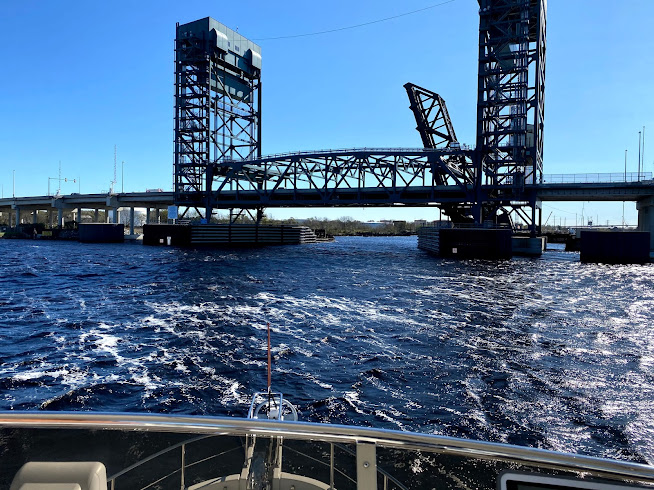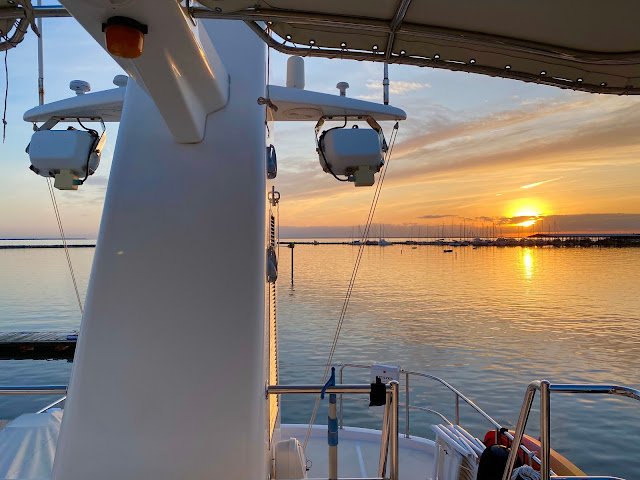How 10 Miles Becomes "60"
.
A quick update...
In early November, we left the boat in Deltaville, VA and drove 1,000 miles in one day back to our home in Petoskey, to have my second tooth surgery. One week later, we drove another 1,000 miles non-stop back to Deltaville. We then took a day to unpack our things and re-provision.
We left Deltaville on November 16 for a 50 nautical mile day to Norfolk, VA. During that day, we saw U.S. Navy ships of all kinds including battleships, aircraft carriers (4 of them), destroyers, medical ships, and tool and supply ships. We also saw many giant container ships.
__________
But this story isn’t about that day. This is about leaving Norfolk the day before yesterday.
The distance I plotted from Norfolk to Atlantic Yacht Basin (AYB) was about 10.5 nautical miles. A light day.
AYB is a well known marina along the northern Intra-Coastal Waterway (ICW). They have a great reputation for repair work and for having low fuel prices.
This is how a distance of 10 miles ended up feeling like it was 60.
__________
The first thing we had to do was leave Waterside Marina in Norfolk. We had gone for a long walk earlier. The weather was beautiful. No clouds, light breeze.
But right when we prepared to leave our dock, the wind suddenly picked up.
We faced a challenge casting off lines. Because two of our lines were tied to the same cleat, I had to untie the boat before we were ready to leave the dock. And that’s when the wind picked up a LOT more.
My dad had to hold the boat dockside against the wind and not let her go forward or backward until I was done untying the rest of our lines. Since the wind was really blowing now, this was way harder than our departure planning.
As soon as I took off our final line and before I could throw it aboard, the wind pushed the boat quickly away from the dock. My dad had to thrust hard to get back to the dock so I could get on.
The next challenge was to leave this tight marina without hitting any piers or other boats. I left our fenders over the side and our lines ready, just in case they were needed.
Doing all of this took real team work and communication. We've had a year working together through lots of situations, so this wasn't totally new to us. We also make a habit of planning in advance, then confirming and re-confirming with each other every step we make -- just as pilots do -- to avoid assumptions or misunderstandings that could lead to accidents.
In the channel, we now faced gale force winds (20+ knots with gusts in the mid 30’s) and a current that was stronger than our systems projected it would be. (A knot, by the way is 1.15 miles per hour.). Though our boat is heavy, she is very tall, so winds like that do push her. And with so much of her beneath the water line, current pushes her even more. When both are pushing in the same direction, it can be come stressful, at least until we get a feel for the situation.
Our 10 nautical mile day was not an open and mostly straight course like the Chesapeake was. This day was narrow, meandering, and windy the whole way. And there was more. Tight bridges to go under, typically with barges moored in them, just to make things even tighter. And shoaling waiting to run us aground if we took our eyes off our course for more than about 15 seconds.
One of the several bridges we passed under. Even though we were in a narrow channel, look at the wind!
So our 10 nautical mile day wasn't going to give us a minute’s rest.
But it was about to get more “interesting.”
About 1/2 way to AYB, we remembered there was a single lock* and a lift bridge right after it we needed to pass through. We'd made a mistake in not planning for them. The lock and bridge work on strict, coordinated schedules. When we ran the numbers, we saw we had a choice.
- Speed up and make the next opening; or
- Slow down and wait for the one after that.
Maybe we could have made it, if we really pushed the boat. But why race to get there? We had no deadline. So we chose to slow down. Also, since our boat is REALLY slow, it would have been a stretch to make the sooner openings. Rushing to get there, only to miss it by a minute would have been stressful, harder on the engine, use more fuel, and likely end in frustration.
__________
[By the way, how slow is our boat? She cruises at around 7 knots if there’s no current facing us. If we push her, we can do about 8.5 knots. But we rarely do that for more than a few minutes for the reasons I just mentioned. Many other boats we see cruise at 15, or 20, or 25 knots. When they do that though, they are burning 3, 4, or many more times the fuel we are. The "many more times" boats are the big sport fish. While we burn 4 gallons of diesel per hour, the smaller sportfish boats burn 20 gallons per hour while the big ones, such as the Viking 55, burn about 70 gallons per hour, cruising at around 30 knots.* Ouch!!! Also, while the range of that Viking is around 500 nautical miles, ours is about 3,500. There are so many different boats for different purposes.]
Here’s a picture of our boat mascot. I call him “Teddy.” My dad calls him “Slow.” It’s an ongoing debate. But you get the point.
__________
The problem with not making the sooner lock and bridge openings was that we would have to wait in the Waterway for about 40 minutes.
Ordinarily, that wouldn’t be a problem. But today, it was a real challenge.
Remember the wind I mentioned earlier? It was peaking now. And the area where we had to hold position waiting for the lock, was in a part of the ICW where the wind blew straight down the channel, like in a funnel. Another thing. Remember I said the Waterway for today’s travel was narrow? Well, holding position in that wind and narrow water was extra challenging.
Shallow water next to a very tight channel. We've learned that seeing all that red on both sides of the boat for a couple hours, or the whole day, is stressful. Especially when the course has lots of turns, meaning we need to keep the boat in the middle during each turn. The red always reminds you that one mistake and...
And here is a video of that sea when we turned around to face it. We learned it was easier to control the boat aiming into the wind. So we kept moving up and down the channel in tight, oblong circles for the 40 minute wait.
When we finally entered the lock, it felt kind of like a friend to me. Last Fall and this Spring, I had been through lots of locks. I'd never added them up until I wrote this. It turns out I've handled a total of 76 locks (58 round trip on the Erie Canal + 2 round trip on the Hudson River + 16 round trip on the Welland Canal). This one is the easiest of them all, with less than a foot’s water change.
My favorite perch on the boat. I sit here every time after I have set up our lines and fenders waiting to enter a lock or until we get near the dock.
__________
What else made our 10 mile day feel longer? When we arrived at AYB we had planned to top up our fuel tanks. Adding 500 gallons (1/3 their total capacity) takes quite a while to pump. We also had planned to pump out our holding tank. Fueling and pumping out meant we had to dock and then move the boat from that dock to our transient slip for the night.
Nozzles at marinas don't have locks. It's probably law. So boaters improvise. Because holding the lever for 30 minutes to an hour or longer would be boring and exhausting. Here's how we we were taught to do it. Tennis anyone? Don't worry. We stay close to it so we don't cause a spill.
Wow, it's free?? Or are they just trying to hide the "bad news?" Actually, it's neither. Fuel prices at marinas change a lot, sometimes daily - or even during the day. AYB posts its fuel prices on its website and on a big sign in front of the fuel dock. They have nothing to hide. And actually their prices are good news, especially when you drive a boat that gets good mileage.
So in total, we had to depart and then tie up three times that day.
All this adds up.
But as I said before, any day on the boat that ends safely is a good day.
This day, which ended safely, had another plus to it. We worked together and handled lots of challenges well. We stretched our skills some more too, which left my dad and me with a feeling of accomplishment. It’s not easy doing that, but it’s how we have come a long way over the past year and a half (in distance and experience) and have become quite a lot more comfortable overall running this boat.
__________
P.S. I decided to make a list of all the things I can think of that make a day moving the boat extra tiring.
Here's what makes for a tiring day.
- Extra long travel distances (when we leave at "0-dark-30" and arrive just before dark).
- High winds (including the noise of high winds).
- Reduced visibility (heavy rain, darkness and especially, fog).
- Swift current.
- Boat traffic.
- Narrow channels.
- Shallow water (I've learned that boaters call it "skinny water").
- Tight bridges (especially when current rips underneath them).
- Locks.
- Things in the water (nets, crab pots, logs, branches, rocks, Jimmy Hoffa?).
- Barges.
- Big wave action, especially when we are facing them head on (I've learned that boaters call that "on the nose").
- Waterway construction and dredging.
- Failure of any onboard system.
- Arguing (boats are small, there is stress, there is lots to do, we get tired, so it's hard not to get on each other's nerves).
And here's what makes for an easy day.
- A day with none of those.
But that's not much excitement or reward, is it?
"A ship in a harbor is safe, but that's not what ships are built for."
- John A. Shedd
__________
* A lock is a device used for raising and lowering boats, ships and other watercraft between stretches of water of different levels on river and canal Waterways.









Lucky you have thrusters and that your dad really likes you. I could have left you stranded on the dock or made you jump. :) Remember, well built boats can take more than the people on them.
ReplyDeleteSalty, why not call the mascot Slow Teddy? Thanks for posting and tell your dad to be careful. Love, Mom.
ReplyDeleteim honesly not sure it just sounded like a good name
Deleteand "slow" is just so blah.